-
An article in The Dartmouth notes the completion of work on Reed and Baker and the start of work on Dartmouth Hall.
-
The HGA [architects] page for the CECS building has an image showing main entrance with the name KEMENY HARDENBERG above the door.
-
The Goody Clancy page on the Irving Institute is up.
-
What might have been: The central and right-hand groups of images on Samer Afifi’s site show (1) a more traditionally-massed CECS on the site where it is now being built and (2) a very unfortunately sited Irving Institute way back on the River Cluster site — not only distant from any important campus axis but also blocking any further Tuck School expansion.
-
This has been noted here before, but it is always fun to see: A Kliment/Halsband-designed addition to the Shower Towers to house Sudikoff. It looks perfectly pleasant, but it must have been overtaken by VSBA planning for Berry Row.
-
Kellogg Auditorium, perhaps the only building at Dartmouth named for a room, has been renamed Kellogg Hall and renovated as a classroom building. It opened last fall (Susan Green, “Newly Renovated and Renamed Kellogg Hall Opens” (29 September 2020)).
-
Dartmouth News has a piece on the importance of the DHMC parking lot as a social space in pandemic times.
-
Many outlets, including the Concord Monitor, have written about the huge college-affiliated apartment complex that will be built on Route 120 at Mt. Support Road.
-
The Davison Block, a prominent and historic commercial building at the top of Main Street in downtown Hanover, has been sold by the Davison family, reports the Valley News.
-
The Valley News also had an article on a sort of Christkindlmarkt that was set up in Hanover over the holidays. Fantastic. So many nice touches could be added to downtown, especially on South Main Street above Lebanon Street, whether by raising the street level (happening?), adding bollards, or limiting traffic and parking. An inviting town square could be delineated in front of the Municipal Building.
-
The Valley News reports on the college’s pullback from the idea of a new biomass heating plant. This is probably good news for the preservation of the old smokestack.
-
There are some great photos in the annual roundup of shots by Dartmouth photographers. The aerial of Baker Lawn does look like a De Stijl painting, as noted. It might look even more like a work in batik, an impression created by the imperfections in the edges of the paths and the snow-covered roofs.
Category Archives: MacLean ESC
Historical archeology on campus and other topics
- News of an archeological dig on the site of Choate House, on Wentworth Street is thrilling; one hopes that such digs take place all over Hanover. Comparing the younger and larger state-supported University of Virginia is not really appropriate, but U.Va. seems constantly to be conducting digs, such as this one last summer.
- In posts of August 17 and September 20, Big Green Alert Daily has photos of the Indoor Practice Facility going up.
- The Valley News has an article on DHMC plans for a northward expansion (see also a later article without the plan). The expansion will go between the arms of the vee at the north entrance:
- Campus Services has a nice interactive map of projects around campus.
- The Rauner Blog has a post on Charles L. Hildreth of the class of 1901 and his campus cyanotypes.
- The Valley News has an article about a class that studied the college’s connection to farming and put up an exhibit in the Berry Brickway Gallery.
- The Engineering/CS construction update page has a photo of the extensively-rerouted Thayer Drive with this caption: “The new access road (to be named Thayer Drive) is almost complete. The drive begins at West Wheelock, turns left behind the residence halls to Channing Cox parking lot, and around to the back of MacLean Science Center.”
- The Digital Library Program is running a great project called Image of the Week.
- One of these things is not like the others. Once the OCD visual identity came out, we knew it was possible, but still we hoped it wouldn’t happen: the college has begun to replace the Dartmouth shield with the D-Tree. The school has started with the official letterhead of all places:

The D-Tree itself is nice, especially as an athletic logo, but it’s not a shield. And while the college might have good reason to take the midcentury Dartmouth shield out of its letterhead, it should commission a new shield for that purpose, as part of a new heraldic coat of arms. See, for example, this proposal from 1995.
Didn’t anyone find it notable that every one of the four Associated Schools now finally has a shield that depicts the Connecticut River in its base, just as the Dartmouth shield does?
- The Valley News reports that the college submitted a new plan for the Thayer/CS building, this time showing its location accurately. After the building opens, wouldn’t it be neat if someone painted a line on the bridge that connects the building to MacLean to show where it was meant to stand? If the college is unable to muster the humility required, then some wry engineering student group ought to do it, in secret.
- The PBS Newshour has a story on the Hood and its unconventional presentation of out-of-the-mainstream art. See also the good art-centered review in Apollo Magazine and the review in Dezeen. Architects Tod Williams and Billie Tsien received honorary degrees at Commencement.
- Rauner Library Blog has a post on a 1946 proposal for a Canadian flag with a profusion of stars, including the Big Dipper (compare the Alaska Flag, at Wikipedia).
- A Valley News article from June describes a tour offered by the Lebanon Heritage Commission.
Remember that time they built the engineering building in the wrong place?
The Valley News reports that the deep excavation for the new Thayer/Computer Science building has been made in the wrong place: it is ten feet to the south of where it should be. The hole for the parking deck that will underpin the building was dug to the correct dimensions but in the wrong location.
Ignore for the moment the implications for an engineering school of this magnificent error (as well as the possibility that the excavation is in the right place but that the Town-approved documents were never updated after some design change). The article presents two options: conduct new excavations to put the building in the right place, or accept the current site and rehash the Town of Hanover approval process. The second option might be less expensive. Once it is re-approved, the planned bridge to MacLean can simply be extended by ten feet.
Various construction topics
- An Architectural Digest story on the Hood by Elizabeth Fazzare again refers to a gray brick supposedly used in the original building, this time stating that it was used in the iconic trabeated gateway. The gateway was made of concrete, however; Moore originally intended it to be of granite.
- The Indoor Practice Facility weekly update includes an aerial image showing the building’s footprint.
- Van Zelm Engineers, a firm that worked on the 1978 Life Sciences Center and has built some very interesting heating plants over the years, are working on the Irving Institute. Their project page shows a basic footprint for the Institute for the first time: it really is a screen building. The college project page now includes renderings of the side facades and a new interior view.
- A flythrough video of the Thayer/CS building by Wilson Architects suggests that the complex will have quite a retaining wall on the west side; one hopes it’s made into “engineering” or at least faced in granite.
- The Thayer School Parking Garage project page has some cute computer images of various stages of future excavation. Turner Construction has a camera on MacLean showing the construction site.
- Campus Services reports on a project to remove diseased trees from Pine Park.
- High-Profile and North Branch Construction have information on the renovation of Blunt into an academic building.
- The Dana renovation remains an interesting project. There is a video flythrough at the Leers Weinzapfel Associates site, and it shows a little pedestrian bridge on the west side of the building. A glimpse of the building’s lobby shows the Guarini shield on an office door and a “graduate lounge” occupying a part of the building, possibly a holdover from the similarly-named space called for in the giant unbuilt dining commons that MRY and Bruner/Cott proposed for a site a few yards to the southwest. The glassy Dana frontispiece will be topped with a patio; the penthouse has a flat canopy roof that is covered in solar panels and almost gives the building the air of a pagoda.
- Some Tuck Drive details from the July 3 minutes of the Planning Board (pdf):
The road is about half a mile long. He stated they will be working within the existing asphalt and drainage swales in order to maintain the existing stone walls. Lighting along the road will be minimal. Fixtures will be spaced 80-120 feet apart. Better access to the loading dock at Murdough will be provided. From Wheelock Street, Old Tuck Drive will be a two way street and give access to the Ledyard Parking Lot. After the turn off to the parking lot, the drive becomes a one way access. There is a pedestrian crossing point marked by a raised speed table. Guardrails will be installed along Old Tuck Drive. There is a bike lane separated from vehicle traffic by a double yellow line. Close to Tuck Drive there will be sidewalks on both sides of the drive.
[…]
Mr. Scherding stated the campus was open with busy streets and students were used to crossing streets and sharing roads. He stated the Director of Public Works suggested narrowing the road at pedestrian crossings to make it safer. Mr. Scherding said they talked about having a physical barrier between the vehicles and the bike lanes but currently it is not on the plans. ESMAY asked what the guardrail would look like. Mr. Scherding stated it would look like the existing granite bollards.
- A report of the September trustees’ meeting describes a renovation project in which “the College intends to improve learning spaces throughout Dartmouth Hall to ensure that the building can meet the needs of faculty and students in the 21st century. As part of the planned construction, the College will restore some of the structure’s historic elements, overhaul the building’s systems, and upgrade its energy efficiency.”
- Revision Energy has a page on its solar installations at the college. Some of the dormitory installations really do transform the appearance of the buildings.
- Bruner/Cott has a page on its renovation of Baker Tower. The interior graffiti appear to have been removed.
- The automated parking system of the UK Architects addition to the rear of the Bridgman Building is drawing some attention (ACPark.com, Parking-Net.com).
- There is more news on the off-campus (or edge-of-campus?) heating plant project (Dartmouth News, The Dartmouth). Although a nice spot for it would be the Dewey Field parking lot (orange), my money’s on a few Lyme Road sites, shown in red:
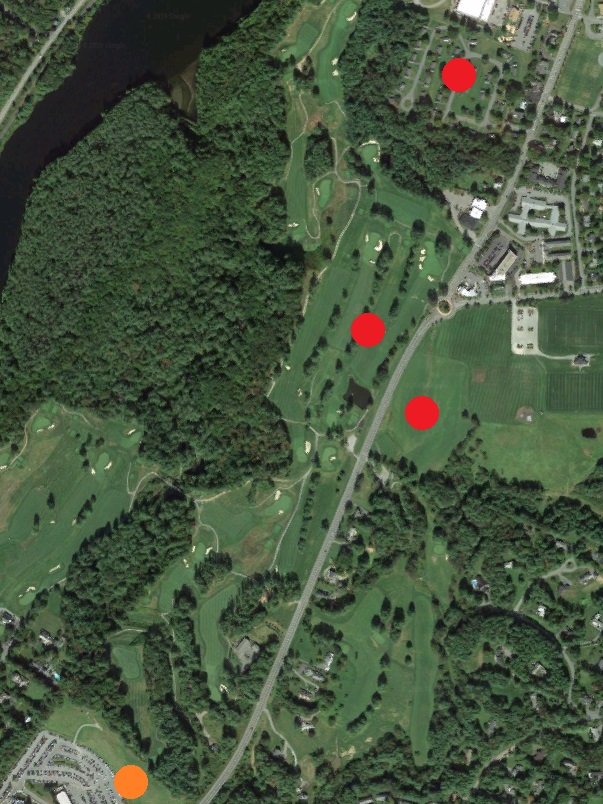
Irving revealed
The college has released several images of the planned building of the Irving Institute at the west end of Tuck Mall.
Goody Clancy, the architecture firm that designed the building, appears to be well regarded by Tuck. Goody Clancy designed Whittemore (1999-2000) and the LLC (2007-2008), a set of connected buildings behind the Murdough Center.
The Institute is straightforward. It is not a “look at me” building, but it is not a shrinking violet either. It needs to be straightforward to live up to the outsized role it has been given in campus-making. A building has been needed here for 50 years, and it almost seems a matter of happenstance that an energy institute is the occupant of this one.
The long, shallow brick range with its steeply-pitched gable makes one think of Centerbrook Architects, maybe that firm’s UConn Chemistry Building.
The flat-roofed glass frontispiece is a bit like the Rauner jewel box. The frontispiece is itself fronted by a minimalist and possibly “High Tech”-style quadristyle temple front, if you could call it that. Again there is no gable, just a flat roof that protrudes to the sides as a set of “wings”; a bit Deco, a bit nautical, a bit like James Stirling’s No. 1 Poultry in London of 1997 (Wikipedia).
The use of the white-painted steel design language, in this building, seems to indicate connections and bridges, and it references nicely the Koetter Kim bridge built in 2006 to connect Murdough and Thayer:
The most remarkable of the new images is the interior view. That cantilevered, glassed-in second-floor corridor visible on the left is the existing black jetty of Murdough:
West End work beginning
The Thayer School expansion involves a lot of changes to an entire district of the campus. Campus Services has information on the overall project.
The page describes the new Thayer School building:
The proposed building, to be located south of the Maclean Engineering Sciences Center, will be constructed over a new three-level parking garage. The garage will replace Cummings lot, and will significantly increase the number of parking spaces in this area. This project will also change the flow of traffic along West Wheelock Street and throughout the West End. Thayer Drive will close, and a new access road will be constructed specifically to provide access to the parking garage, and Thayer loading docks and the Channing Cox parking lot. Old Tuck Drive will be reconstructed and reopened to support one-way traffic heading from west to east. Improvements to the intersection of West Wheelock, West Street, and the new access road will also be made to improve access and safety of pedestrians, cyclists and drivers.
Dartmouth News has a story on the proposal for a new set of stoplights on West Wheelock Street at Thayer Drive (see also the Valley News).
We learn from the college news story that the Thayer School building “will be connected at ground level to the MacLean Engineering Sciences Center and Cummings Hall.” Presumably “at ground level” means aboveground as opposed to belowground, where the garage is. Because renderings show only a second-level bridge connecting the new building to MacLean; pedestrians will go under the bridge to follow the “Green to Blue” route. See this rendering reproduced from the latest Dartmouth Life print publication (showing the existing brick wall of MacLean in white on the right):
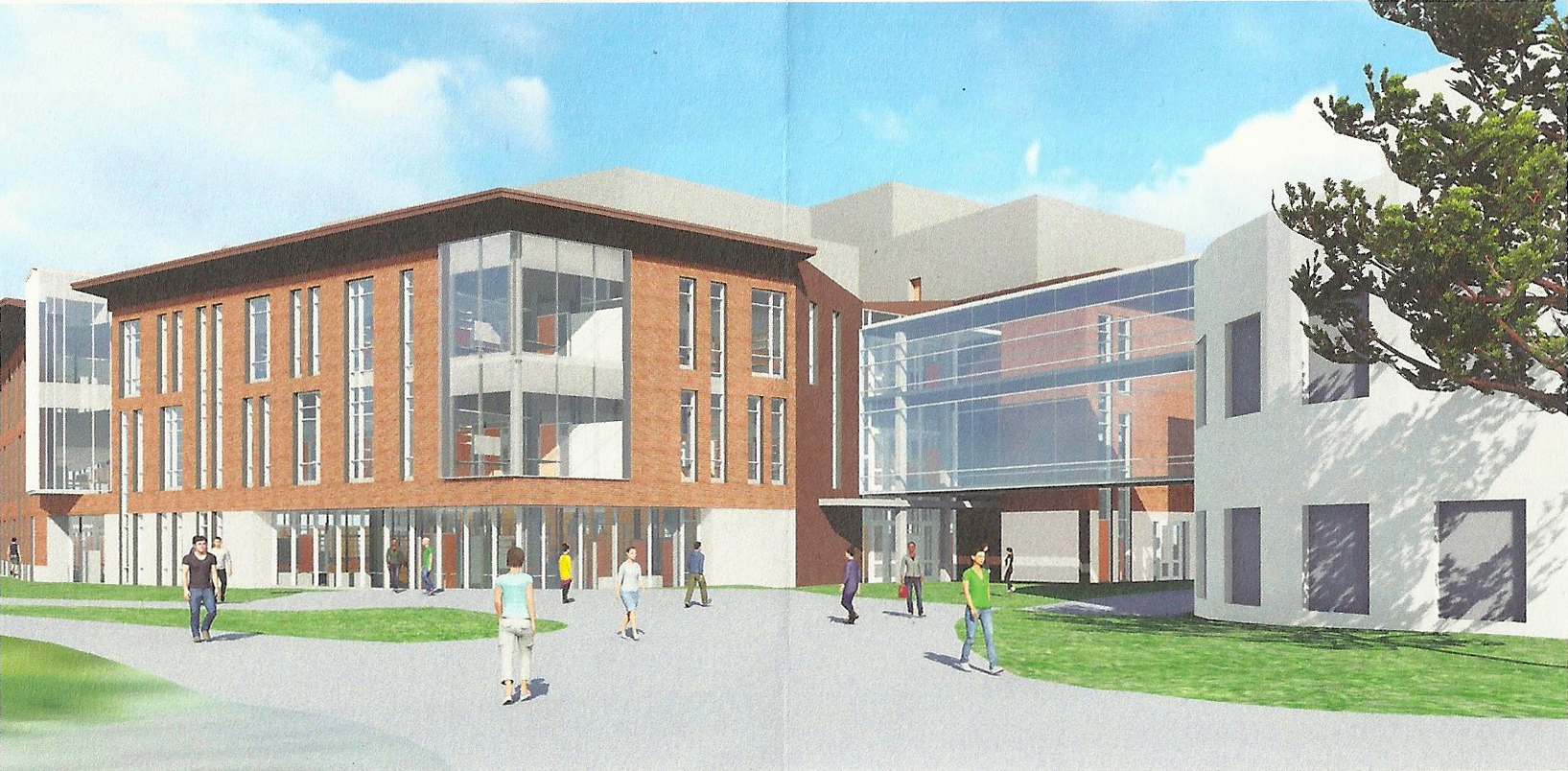
Incidentally, the college’s project manager for the Beyer Blinder Belle West End Master Plan was planner Douwe Wieberdink; he’s now with BBB. And the landscape architects for the West End work are Michael Van Valkenburgh Associates: perhaps one can feel a bit better about the fate of historic Tuck Drive following its partial demolition.
Details on the new road to the Thayer & CS building
The BBB West End Master Plan (super image from BBB site; see also the Campus Services project page, written by BBB) turns out to be more than a schematic design. The meandering suburban business-park road is going to be built:
Another change will be the removal of Engineering Drive, which runs from West Wheelock Street to the Cummings lot. A new roadway, called West Access Road, will be constructed to provide access to the parking garage and Thayer loading facility as well as limited access to the West End Circle. A now-closed portion of Old Tuck Drive, which originates just above the swim docks and the Ledyard parking lot, will be reopened and will connect the roadway to Tuck Mall, pending town approval.11. Susan J. Boutwell, “Integrating Engineering, Computer Science, Entrepreneurship,” Dartmouth News (28 March 2018).
The project page for the Thayer/CS building provides more detail: “Engineering Drive will close, and a new access road will be constructed specifically to provide access to the parking garage and Thayer loading docks. Old Tuck Drive will be restored and reopened to support one-way traffic heading from west to east.”
Maybe the site conditions (steep slopes, existing buildings) require the endearingly-named West Access Road to look the way it does. After all, Tuck Drive22. Please, let’s stop calling it Old Tuck Drive. The word “Old” seems to have been added to the name of Tuck Drive to distinguish the short branch of the road that was eliminated by Fahey-McLane. That was a dozen years ago. There is no need to keep using the word. is a curving, naturalistic auto road. Yet one hopes that the new road will respect urban principles by reinforcing campus spaces.
One also hopes that the West Access Road will be reconnected to Tuck Mall once construction of the building is completed: that would seem to be the reason for the two-level pedestrian bridge that will join the building to the McLean ESC.
From the Dartmouth News article: “Construction is expected to start early next year on a three-level underground parking and loading facility, which will sit below the four-floor education portion of the building.” In the map that accompanies the article, the entrance to that subterranean lair underground garage appears just off the southwest corner of the new building. Last fall, the project page included a view of the building’s south facade from which is taken this detail showing the intriguing, grottolike entrance:
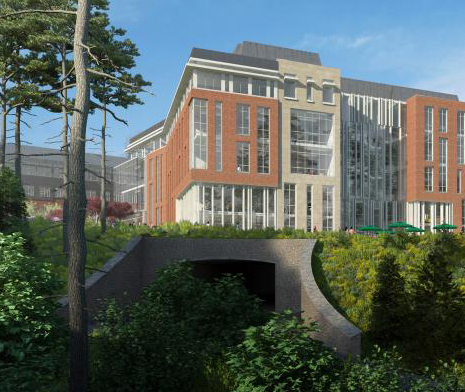
| ↑1 | 1. Susan J. Boutwell, “Integrating Engineering, Computer Science, Entrepreneurship,” Dartmouth News (28 March 2018). |
|---|---|
| ↑2 | 2. Please, let’s stop calling it Old Tuck Drive. The word “Old” seems to have been added to the name of Tuck Drive to distinguish the short branch of the road that was eliminated by Fahey-McLane. That was a dozen years ago. There is no need to keep using the word. |
Ledyard Canoe Club demo ahead
-
A campus construction update has a few details on the soccer pavilion expansion out at Burnham Field.
-
The Valley News reports that the new Dartmouth Coach bus station is opening in Lebanon.
-
An architect has been named for the Ledyard Canoe Club replacement. The historic clubhouse will be demolished and a new building built in its place by Charney Architects of New Haven.
-
A newsletter last month described the installation of a solar array at ground level on Berry Row.
-
The Moosilauke Ravine Lodge replacement (project page) is going ahead, and one can’t help but worry about the success of its central feature, the great stone fireplace-staircase (HearthStair?). Will it be plausible as a work of masonry, a little bit of Machu Picchu in the White Mountains? Or will it read as Formstone, with no visible means of support?
-
An item on memorializing the Lodge mentions some interesting digital projects and quotes OPO Director Dan Nelson: “Memorabilia will be saved, safely stored, and reinstalled; interior log elements will be reused; timbers that can’t be reused in construction will be sawn into planks for wall paneling.”
-
“Work is underway … planning for future renovation of the Hopkins Center” (news release; see also the story in The D).
-
“Also in the future is consideration of the north end of campus, focusing on the demolition of Gilman Hall — and creation of green space in its place” (The D). Let’s hope that this is a way of saying the Gilman site will not become a parking lot.
-
“— coupled with the complete renovation of Dana Hall for faculty use” (The D). Interesting — wasn’t the library moved out because Dana was to be demolished? Is that move now looking like a mistake, or would the renovation have required the building to be emptied anyway? Whatever the case, it’s good to hear that Dana is being renovated. It seems like an underappreciated building that might have some merit to it, some endearing features. The small size and the scale of the building are appealing.
-
The Rauner Blog has a post on the Surveyor General of the His Majesty’s Woods during the 1740s. It is worth noting that John Wentworth later became Surveyor General, and Eleazar Wheelock was accused of illegally harvesting pines marked with the King’s broad arrow.
-
Dartmouth is building a timber-framed pavilion at the Organic Farm to shelter a wood-fired pizza oven (Planning Board minutes 6 September 2016 pdf).
-
Dartmouth Engineer Magazine has a long article on the Williamson Translational Research Building by The Map Thief author Michael Blanding.
-
The D has an article about the end of football game broadcasts on campus radio; this year the football team switched to 94.5 ESPN. Dartmouth licensed athletic multimedia rights to Learfield Sports late last year. Learfield created Big Green Sports Properties to handle “all corporate sponsorship endeavors for the Big Green, including venue signage, promotions, radio advertising and ads on DartmouthSports.com” (new general manager announcement).
-
Mad River Glen ski area in Vermont is the only ski area on the National Register (history, NR nomination form pdf).
Planning the western part of campus
In September the college released a framework plan for potential construction around the professional schools (news release, story in The D). The plan, by Beyer Blinder Belle, elaborates on that firm’s earlier master plan for the campus.
The plan shows several future buildings. One is the upcoming Thayer School/Computer Science building, on the site of the Thayer parking lot (new images released). Another is the Irving Institute building in front of the Murdough Center (some details released). The designer of the Irving Institute is KPMB Architects, a Canadian firm: the school’s press release notes that each of the firm’s three partners is a member or officer of the Order of Canada. The plan also shows the demolition of the final two River Cluster dormitories, although the school has not selected a site for the replacement beds yet.
It is good to hear that the planning involves the “consideration of the aesthetics of future buildings and improvements to signage.” The future buildings depicted in the plan image do seem to perpetuate the oddly suburban bias noted in the original BBB master plan, however.
Lisa Hogarty, at the time the Vice President of Campus Planning (The D), said that “This plan creates a route from the Green to the river and adds new community green space.” The new route to the River is shown in the illustration and includes a ped-bike bridge over the cemetery. The “new community green space” is presumably an improvement of the existing “Whittemore Green” behind Thayer School. Some work has been done here, but it still feels a bit like leftover space, the grassy area in the middle of the asphalt turnaround.
A better image of the future Engineering/CS building
OPDC has a project page for the new Thayer School building with an image from this point of view (Google Street View).
The building will occupy the Thayer parking lot and connect to MacLean by a two-level glass bridge. Wilson Architects is designing the building (MacLean is by Koetter, Kim).
Computer Science Department to move to new Thayer School building
Google Street View
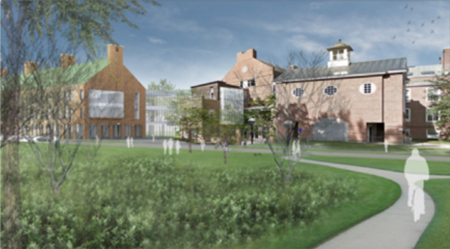
The new building is on the left. Image from Behind the Green newsletter.
The Thayer School of Engineering is planning to expand its faculty, students, and program. They are working closely with our Planning, Design & Construction Office to design a building that will accommodate this growth. The project is being developed in partnership with the Computer Science department and will therefore accommodate the relocation of that department, promoting interaction and collaboration between Thayer and CS, and with Tuck as well. The proposed new building is located south of the Maclean Engineering Sciences Center on the west end of the Dartmouth campus.
That from the Campus Services newsletter.1”A Sampling of Capital Projects Underway,” Behind the Green (2 March 2016) pdf.
The building takes its cues from the successful MacLean ESC next door. It looks as if it will line up directly with the portico of Tuck Hall.
The building also carries on the Thayer tradition of erecting additions rather than freestanding buildings. This is contrary to the two most recent master plans for this area. The road seems to be rerouted at least; will the connection to the River Cluster be eliminated completely?
And who will take over Sudikoff once CS leaves?
The newsletter also has a small rendering of the upcoming Indoor Practice Facility.
——————————
Thayer new building details
Thayer School news from the Valley News:
In 2017, administrators hope to break ground on a new building for the Thayer School of Engineering, located near the Tuck School of Business at the western end of campus.
Joseph Helble, dean of the Thayer School, said the expansion would help to accommodate rising numbers of students and faculty, as well as increased need for lab and office space.
“Our undergraduate enrollments have grown tremendously, roughly doubling over the past 5 years, so we are in need of more classroom space, including ‘project labs’ where students work on open-ended, hands-on design projects, usually in teams,” he said in an email Sunday.
The new building would be built in place of the parking lot south of the Thayer complex, according to Hogarty, who said the cost of the project had not been fixed but was planned to come entirely through donations.
Siting a new building for Thayer School
The Dartmouth reports that Wilson Architects is “exploring potential designs and locations” for a new Thayer School building:
The parking lot is the most obvious site, Helble said, though it would create a need for another parking facility elsewhere.
The firm will present its report in January. Wilson Architects, of Boston, has worked on a design for the renovation of Fairchild Hall.
MacLean’s fourth floor addition
A post at Dartmouth Engineer notes that a 3,000-square foot office addition has expanded the fourth floor of MacLean (2004-2007) and links to a photo.
In this before image, the main block of the building is only three levels high:
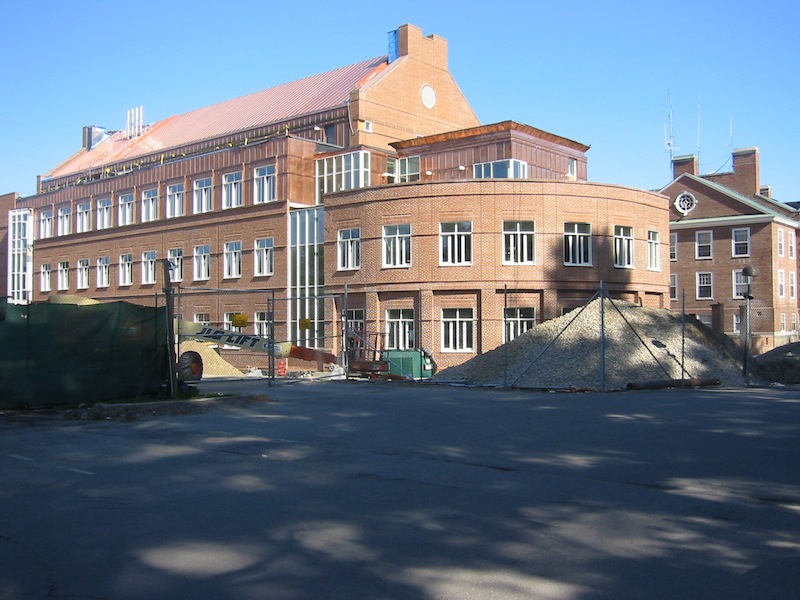
The design of the addition, like that of the building, is by Koetter | Kim & Associates (see NH Forum (November 2011) (pdf)).
A snippet of a 2004-era Thayer School master plan
The Koetter | Kim & Associates website includes an intriguing sketch, of which this is an excerpt:
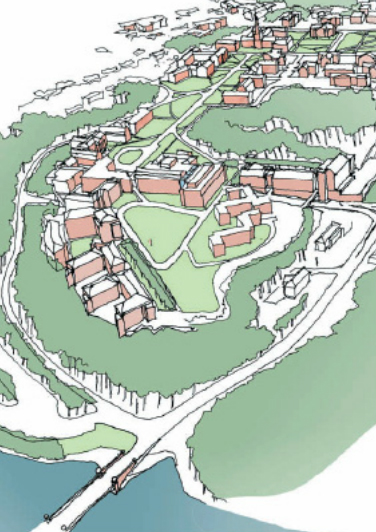
Note the expansion of Thayer School all the way down Thayer Drive to West Wheelock Street, giving a “public” face to engineering (or business, for that matter) for the first time. Bold! Although the scale of the buildings in the image might not be the most appropriate, this would be a better use of the vacant land than what exists.
Source: Koetter | Kim & Associates > Projects > Projects List > MacLean Engineering Sciences Center > fourth image.
“Whittemore Green” as a name
As the irregular grassy plot in front of the River Cluster becomes better defined and and is transformed into a front door to the Tuck School (through the school’s Whittemore Hall), the space needs a name.
Landscape architects Saucier & Flynn have mentioned “Whittemore Green” in town planning meetings (pdf).
—–
[Update 11.17.2012: Broken link to 11 July 2006 minutes removed.]
MacLean is complete, exterior views available
The Office of Planning, Design & Construction continues to generously post photos of construction projects, including final views of the exterior of the MacLean Engineering Sciences Center at the Thayer School.
MacLean progress visible at Thayer School
The MacLean Engineering Sciences Center was clad in brick during the fall and now presents a recognizable form. See construction photos.